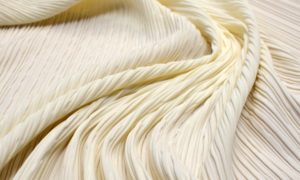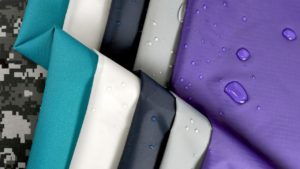What Is Polyamide And How Is It Made?
Jump To:

Polyamide has become a synthetic fiber as popular as polyester and is found today in the composition of many textiles. But what is its origin? How is it designed? Is it harmful to man and the planet?
Polyamides were discovered in 1927 by the American company of Pont de Nemours and, more precisely, by Wallace Hume Carothers. Polyamides are thermoplastic polymers; they are obtained through the polycondensation of diamine and diacid. There are several types of polyamides (6, 6-6, 11, 12, etc.).
To put it simply, polyamides are plastics from the chemical industry and are made from petroleum. Polyamides, like nylon, were quickly used in the textile industry for their valuable properties.
The properties of polyamides
- Solidity
Like many synthetic fibers, polyamide is very durable and often mixed with other textile materials to strengthen fabrics.
- Extensibility
Polyamide fibers are stretchable and resistant. They make it possible to make clothes that do not deform.
- Lightness
Polyamide fibers can be used to make very light and not very fragile fabrics, thanks to their strength.
- Impermeability
Polyamide fibers absorb very little water. They are therefore ideal for making outdoor clothing resistant to rain.
Polymide Uses
These polyamide fibers are widely used for the composition of clothing fabric. The strength and excellent resistance of these threads have conquered the world of clothing and textiles. Thus, this material is found in many clothes (jeans, fleece, sweaters, sweatshirts, curtains, T-shirts, swimsuits, shorts, etc.).
Lightweight and resistant, it is commonly used as a lining for coats, jackets, and small leather goods. It is the main material of swimwear and sportswear, as well as raincoats and umbrellas. It is possible to find polyamide in the material of the hose clamps.
What are the differences between polyesters and polyamides?
- From a functional point of view, these two fibers are similar even though polyamides have greater elasticity than polyester.
- From a manufacturing point of view, these two fibers are not very different either because they both come from a chemical process based on petroleum.
The qualities of each other make their uses different. For example, for sports activities, polyamides, added to elastane, constitute a winning duo that considers consumers’ expectations and respects their freedom of movement. This breathable garment which dries quickly, is an asset for athletes of all levels.
Polyesters absorb less perspiration. On the other hand, they are preferred for boat ropes because of their longevity, excellent quality/price ratio, and high UV resistance.
The undeniable advantage of polyesters is their cost, which is significantly lower than polyamides. However, the latter is of much better quality, and it is this decisive advantage will give better publicity to this product.
Is nylon a polyamide?

This product comes from the plastics industry and, more precisely, from the family of polyamides. The chemical process uses two components, hexamethylene diamine, and adipyl chloride, which, when combined, will cause a solidification reaction. The result of this operation is a fiber that will be packaged in a coil.
Nylon was seen as a revolution in textiles as it helped replace silk in the manufacture of stockings for women. Its finesse and consistency have made seamless stockings possible that does not slip. These were very successful as soon as they were put on the market. These clothes are functional, light, and dry very quickly. They are generally woven in two different ways.
The non-textured flat yarn allows ready-to-wear articles, linings, sportswear, raincoats, or dresses. In contrast, the textured synthetic yarn is used precisely to manufacture stockings, socks, tights, or even swimsuits.
The dangers of polyamide
Polyamide has the same negative impacts as all synthetic fibers from petrochemicals. These fibers represent a danger for the planet and humans.
Polyamide is a polluting fiber, and its manufacture requires significant consumption of natural resources (energy and oil). Despite this, it is still widely used by Fast Fashion brands because it is a cheap fiber.
Alternatives to polyamides
To avoid polyamide, the ideal is to turn to natural materials such as organic cotton, linen, recycled cotton, etc., or chemical materials made from natural and environmentally friendly materials such as Tencel, Modal, etc.
